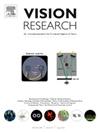Determining fixation accuracy with optical coherence tomography and its implication on visual acuity in amblyopia
IF 1.4
4区 心理学
Q4 NEUROSCIENCES
引用次数: 0
Abstract
Inaccurate fixation is a hallmark of strabismus and amblyopia. Recently, positional error of fixation in amblyopic children was assessed with Optical Coherence Tomography (OCT). This study extends the use of OCT to examine both positional error and stability of fixation in an adult population and investigates how lifelong impairment of fixation can impact visual acuity in amblyopia. Twenty macular cube scans per eye were acquired with the Cirrus HD-OCT in 30 amblyopes and 30 controls with normal binocular vision. The foveal location was identified with the instrument’s software as line scan coordinates to determine the distance between the fovea and the center of the scan. The average positional error and stability of fixation were calculated utilizing the foveal location measurements. Crowded monocular distance visual acuity (VA) was obtained from each eye. Amblyopic eyes demonstrated greater position error and fixation instability compared to fellow and control eyes. Simple linear regressions revealed a significant relationship between both position error and VA and fixation stability and VA. However, with multiple regression, position error alone was the significant predictor of VA. Fixation accuracy analysis from OCT imaging provides a quantitative assessment of fixation behavior, allowing for more comprehensive clinical management of amblyopia and predicting visual acuity.

光学相干断层扫描测定弱视的注视精度及其对视力的影响
不准确的注视是斜视和弱视的标志。近年来,利用光学相干断层扫描(OCT)对弱视儿童的固定位置误差进行了评估。本研究扩展了OCT的使用,以检查成人人群的定位误差和固定的稳定性,并研究终身固定损伤如何影响弱视的视力。用Cirrus HD-OCT对30名弱视者和30名双眼视力正常的对照组进行每只眼20次黄斑立方扫描。该仪器的软件将中央凹位置识别为线扫描坐标,以确定中央凹与扫描中心之间的距离。利用中央凹位置测量计算平均位置误差和固定稳定性。每只眼的拥挤单眼距离视力(VA)。弱视眼与正常眼和对照眼相比表现出更大的位置误差和注视不稳定。简单的线性回归结果显示,位姿误差与视压、固定稳定性和视压之间存在显著关系。然而,多元回归结果表明,位姿误差是视压的重要预测因子。OCT成像的固定精度分析提供了对固定行为的定量评估,从而为弱视的临床管理和预测视力提供了更全面的依据。
本文章由计算机程序翻译,如有差异,请以英文原文为准。
求助全文
约1分钟内获得全文
求助全文
来源期刊

Vision Research
医学-神经科学
CiteScore
3.70
自引率
16.70%
发文量
111
审稿时长
66 days
期刊介绍:
Vision Research is a journal devoted to the functional aspects of human, vertebrate and invertebrate vision and publishes experimental and observational studies, reviews, and theoretical and computational analyses. Vision Research also publishes clinical studies relevant to normal visual function and basic research relevant to visual dysfunction or its clinical investigation. Functional aspects of vision is interpreted broadly, ranging from molecular and cellular function to perception and behavior. Detailed descriptions are encouraged but enough introductory background should be included for non-specialists. Theoretical and computational papers should give a sense of order to the facts or point to new verifiable observations. Papers dealing with questions in the history of vision science should stress the development of ideas in the field.
 求助内容:
求助内容: 应助结果提醒方式:
应助结果提醒方式:


